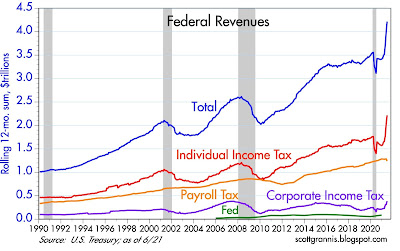In my previous post I referenced the huge increase in the M2 money supply over the past 16 months, noting that much of the increase that occurred in the wake of the Covid panic (I estimated as much as $3 trillion) was money that likely was no longer wanted by its holders, given the improvement in confidence, the rapid decline in Covid cases, and the subsequent improvement in the economy. I further argued that this unwanted money was the likely fuel for the rising prices of many goods and services. This post provides some data to back up my point.
Chart #1
Chart #1 shows the level of Bank Reserves provided by the Fed to the banking system. Reserves are the only type of money the Fed can directly "create," and reserves can only be created for the purpose of buying high quality assets, which typically means Treasury securities—but more recently has come to include mortgage-backed securities and some corporate bonds. The Fed purchases these assets from the banking system, and the reserves it uses to pay for them are credited to the banks' accounts at the Fed. Reserves cannot be used to buy anything else, and they are only and always held on the Fed's books (i.e., they are liabilities on the Fed's balance sheet). Banks have traditionally held reserves as collateral for new lending, since by law banks must hold reserves equal to about 10% of their deposits. Today, however, banks hold reserves far in excess of what is required, and they do so because in 2008 the Fed started paying interest on reserves—and that, in turn, made bank reserves functionally equivalent to T-bills: high quality, liquid, default-free and carrying a floating interest rate. Prior to 2008, reserves were "dead" assets since they paid no interest yet banks were required to hold them—so banks tried to hold as few reserves as possible.
The current huge amount of bank reserves means that banks have effectively lent boatloads of money (about $5 trillion) to the Fed, and most of that money has come from huge deposit inflows to checking and savings accounts. Banks also lend money to the private sector, of course, but lending to the Fed carries no risk while paying a very modest rate of interest—currently 0.15%. If banks decide that the 0.15% interest they receive from the Fed has become unattractive relative to what they could earn by lending to the public sector (on a risk-adjusted basis), today's huge level of reserves means that banks have a virtually unlimited capacity to expand their lending—which is what expands the money supply. Only banks can create spendable money under our fractional reserve banking system. When a bank decides to lend you money, they simply credit your account with newly-minted money. You then use that money to buy other things, and that money enters into circulation as someone else receives it in their bank account.
As the chart also shows, the Fed has expanded its issuance of reserves by about $2.24 trillion since February of last year. This is almost as much as the $2.8 trillion of reserves created by three previous waves of Quantitative Easing from late 2008 through mid-2014. Those three waves of Quantitative Easings didn't lead to an unusual pickup in inflation, but QE4 did. Why is that?
Chart #2
At the beginning that was fine, since everyone scrambled to stockpile money as the economy shut down. But now people's desire to hold money is very likely declining as life gets back to normal. I'm guessing there's as much as $3 trillion of money in the banking system that is now "unwanted."
The problem, of course, is that money can't just disappear if people don't want it. If I want to reduce the balance in my bank savings account, I need to spend it on something else. The person who receives my money must then do something with the money.
There are three ways the banking system can get rid of unwanted money: 1) Borrowers can pay off their bank loans (since bank lending is the fount of all money supply growth), 2) the Fed can drain reserves from the banking system by selling some of the bonds it bought (thus reducing excess bank reserves and banks' ability to increase lending), and 3) inflation can increase the price level and the level of incomes by enough to return people's desired cash balances (e.g., the ratio M2 to annual incomes) to reasonable levels. I think #3 is going to be the dominant factor.
What we have seen in the past 16 months is unique in the monetary history of the US: a massive and sudden expansion of M2 that far exceeds anything we've seen before. To me, it's no surprise that inflation is surging.















